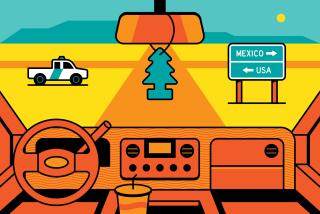‘Lost Lives’ May Crack N.Y. Shell
- Share via
The U.S. border with Mexico may be the busiest in the world, and one of the most volatile, but to many New Yorkers, the Hudson River is the border that really counts, the one that distinguishes between two truly disparate realities: New York and the rest of the country.
Such insular thinking pervades even the city’s most sophisticated circles, and is deeply entrenched in its art community, whose museums, galleries and publications claim to speak for the entire nation.
If anything could crack that hard shell in the minds of Manhattan’s gallery-goers, it would be a show by the Border Art Workshop/ Taller de Arte Fronterizo (BAW/TAF). The San Diego-based artists collaborative opened its first show outside California on Thursday in the 4,000-square-foot gallery of Artists Space in lower Manhattan.
Titled “ Vidas Perdidas /Lost Lives,” the exhibition focuses on the issue of undocumented workers who come to the U. S. “and die either physical or spiritual deaths,” according to workshop member Robert Sanchez.
Visitors to the show start out, figuratively, in Mexico, and in passing through a series of installations, are confronted with the physical and cultural transitions experienced by those crossing the border to the United States. The directed traffic pattern employed in the show recalls the labyrinthine course of the group’s most recent show in San Diego, the highly provocative and successful “Border Realities IV: Casa de Cambio “ at the Centro Cultural de la Raza last summer.
The sound of cars on the freeway permeates one room designed (by workshop member Michael Schnorr and collaborators Elizabeth Sisco and Susan Yamagata) to re-create the landscape of the San Diego-Tijuana border. Two cars jut threateningly out of the wall, calling attention to the rash of deaths of migrants crossing the freeway on foot.
Another installation, by workshop members Sanchez and Berta Jottar, focuses on undocumented workers exposed to pesticides in the flower-growing fields of San Diego’s North County. Jottar’s contribution concentrates on the health problems of women working in these fields, and the irony of “low-risk roses causing high-risk pregnancy.”
The New York audience is not well-informed about such issues, most Border Workshop members agree.
“To people outside the Southwest United States, Mexico is nouvelle cuisine restaurants and movies, but the social realities of Mexico are remote,” said Guillermo Gomez-Pena.
Ignorance obeys no borders, however, and Jottar pointed out that even people in California are not well informed about the conditions of undocumented workers.
Members of the workshop stress the educational aspects of the exhibition; statistics, facts and documents accompany the thematic environments. New Yorkers, they hope, will not only learn more about the actual conditions of undocumented workers in Southern California, but will be prompted to draw connections to their own experiences and the experiences of their fellow Easterners.
“In many ways, I think New York is a border city, with a complex hybridization of languages and cultures,” said Gomez-Pena. “That is what our border sensibility is all about, so I think that can be understood and felt in Manhattan.”
New York has always had a substantial immigrant population. Its undocumented workers simply have different anxieties from those in the border region, according to group member Richard Lou.
“There aren’t borders between countries here, but there are borders between one community and another, and we’ll draw strong parallels from that. We hope this will be the impact of our show, that this is not a regional issue, but an international issue.”
For Schnorr, the issues are universal.
“We’re talking about how people are treated, and people are people,” he said. “Now it’s Mexicans. Ten years from now, who knows? The point is that the issues are present-day and need to be addressed.”
Whether the New York audience responds to the urgency of such issues remains to be seen. Attention spans are limited in the star-struck gallery world of Manhattan, and, as Sanchez said, “it’s inevitable that things become like a flavor of the month.”
Artists Space director Susan Wyatt hopes the Border Art Workshop show will offer an alternative to the hype that taints the current art scene.
“New York sometimes gets very jaded about things,” she said. “I think, by trying to find work that deals with life-and-death issues, it jars the audience a little and gets them to think about what they could be doing.”
While the Border Art Workshop has had a commanding presence locally during its five years in existence, its national and international exposure has been minimal. With this show, and an accompanying, retrospective catalogue (funded primarily by Artists Space, with support from the La Jolla Museum of Contemporary Art and the California Arts Council), the group’s visibility is bound to expand, and with it, the attention paid to the cultural, physical, philosophical, historical and personal issues that define the border region.
“Traditionally, the art world hasn’t focused on people who are deterritorialized,” workshop member Emily Hicks said. “We want to get these ideas out to broaden what the art world can deal with.”
Other participants in the Artists Space show, which runs through Feb. 18, include group members Victor Ochoa and Rocio Weiss and collaborator David Fobes.
More to Read
The biggest entertainment stories
Get our big stories about Hollywood, film, television, music, arts, culture and more right in your inbox as soon as they publish.
You may occasionally receive promotional content from the Los Angeles Times.










